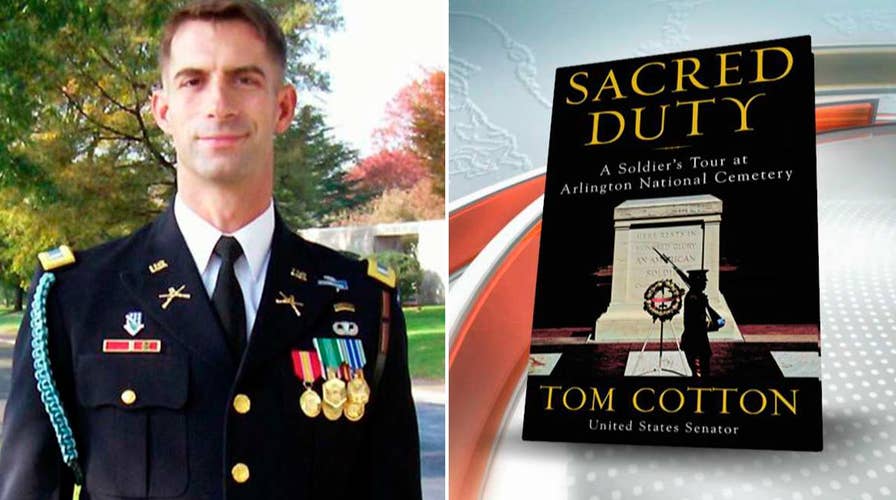Sen. Tom Cotton discusses his new book 'Sacred Duty'
Sen. Tom Cotton, R-Ark., praises the sacrifices of America's fallen heroes.
Memorial Day is our most sacred national holiday, the official occasion when we honor our fellow Americans who gave their lives in defense of our nation. On this weekend, Arlington National Cemetery, more than any other place, embodies the reverence and love that we, the living, hold for our fallen.
Every headstone at Arlington tells a story. These are the tales of heroes, stories of service and sacrifice we all should pause to remember as we gather with friends and families this weekend.
But not all families will be together. Thousands will make a bittersweet journey to Arlington’s bucolic fields to visit their loved ones. Old battle buddies will travel to Section 60, the eternal home at Arlington of those killed in the War on Terror, to remember and pay tribute to their fallen comrades. For me, this Sunday marks the 10th anniversary of the death of Lt. Col. Mark Stratton, with whom I trained before our deployment to Afghanistan and who perished in a bomb blast.
DEFACED WAR VETERANS MEMORIAL RESTORED FOR MEMORIAL DAY
Awaiting at Arlington are small American flags at every grave and niche, nearly 245,000 in all, from the oldest military gravesite — that of Private William Christman, buried on May 13, 1864 — to the newest ones distinguished by their fresh dirt and small black markers as they await headstones. A small flag also adorns President John F. Kennedy’s eternal flame and the Tomb of the Unknown Soldier, just as it does the humble graves of many other unknown soldiers.
Those flags are a living testament to our respect, our gratitude, our love for those who have borne the battles of a great nation, and hence those who will bear the burdens of tomorrow.
On Thursday afternoon, the 3rd United States Infantry Regiment—better known as The Old Guard — placed these flags throughout the cemetery. This tradition, known as Flags In, is now in its eighth decade.
For The Old Guard, Flags In is a major military operation. Planning and rehearsals began months ago. Key leaders used overhead imagery with phase lines to direct their troops, just as happens in combat. Support troops managed the logistical demands of transporting so many flags, as well as water for more than 1,000 soldiers laboring under the hot sun. Young soldiers hung up their dress-blue uniforms after the day’s last funerals and donned their combat fatigues for the march back into the cemetery.
I served with The Old Guard in 2007-08, and I still remember the pre-mission briefing. Place the flags “vertical and perpendicular to the headstone.” Use your boot to measure the distance from the headstone to the flag. But only one soldier per row, lest different boot sizes disrupt the perfect symmetry of the flags. Salute a grave site when the headstone contains the Medal of Honor, a military custom to honor our nation’s highest decoration for battlefield valor.
These standards are just small examples of how The Old Guard executes the Flags In mission with the same care and attention to detail as they perform military-honor funerals in the cemetery. Nor did the mission stop on Thursday. Old Guard soldiers conduct roving patrols throughout the weekend to replace flags shifted, damaged, or removed by weather or visitors.
Flags In symbolizes our national dedication to those heroes who gave “the last full measure of devotion,” as Abraham Lincoln put it at Gettysburg. Each flag demonstrates that every veteran resting in Arlington, no matter how long since passed, had a moment of remembrance this weekend with an inheritor of his or her legacy. In that moment, the soldiers who planted those flags delivered a simple message on behalf of a grateful nation: you are not forgotten.
CLICK HERE TO GET THE FOX NEWS APP
That message is heard not only by the dead and their families, but also the living. Young soldiers who visit Arlington this weekend, even boys and girls who one day will answer their nation’s call to duty, hear that message as well. And we would all do well to hear it. Those flags are a living testament to our respect, our gratitude, our love for those who have borne the battles of a great nation, and hence those who will bear the burdens of tomorrow.
No one summed up better what Arlington and The Old Guard means for our nation than did Sergeant Major of the Army Dan Dailey. He recalled to me a moment with a foreign military leader while driving through the cemetery to lay a wreath at the Tomb of the Unknown Soldier.
"I was explaining what The Old Guard does and he was looking out the window at all those headstones," Dailey said. "After a long pause, still look at the headstones, he said, 'Now I know why your soldiers fight so hard. You take better care of your dead than we do our living."
This text has been adapted from the best-selling book, "Sacred Duty: A Soldier’s Tour at Arlington National Cemetery."

